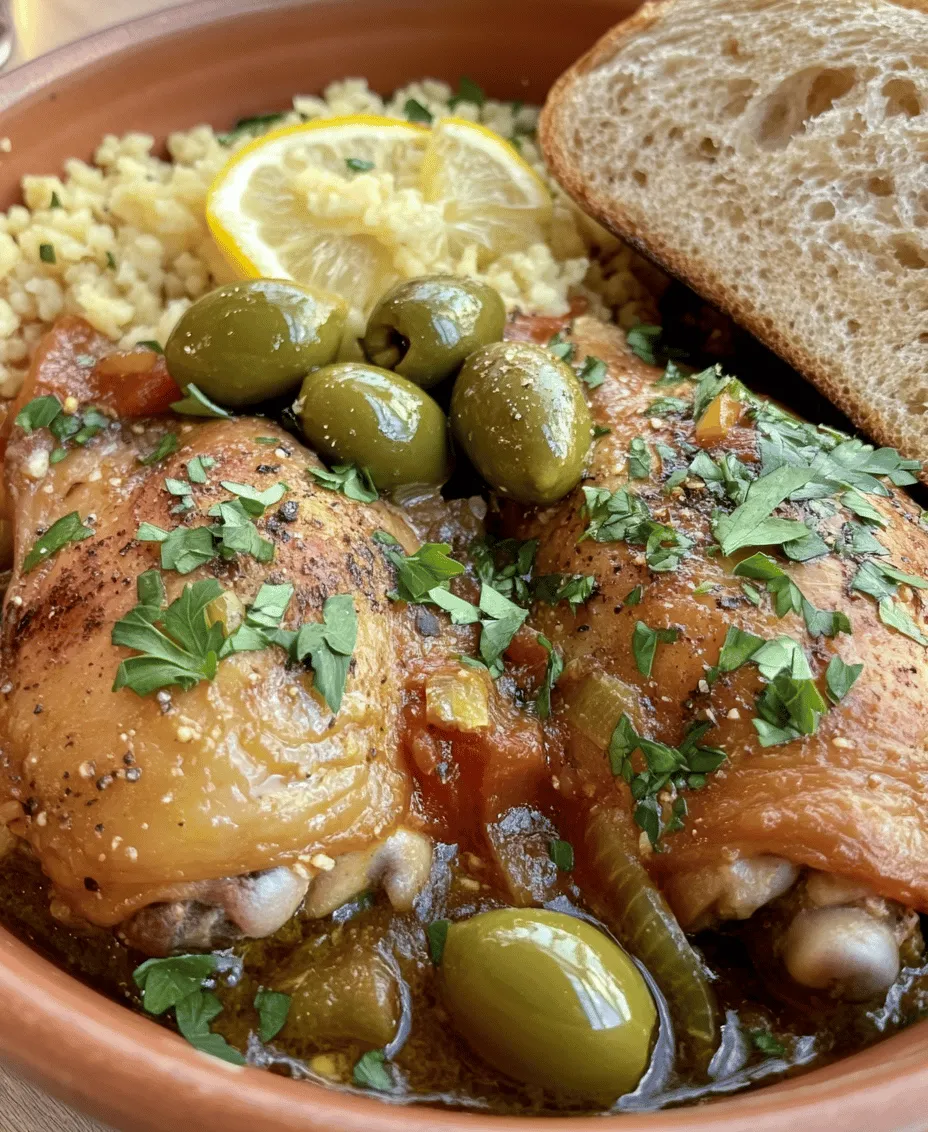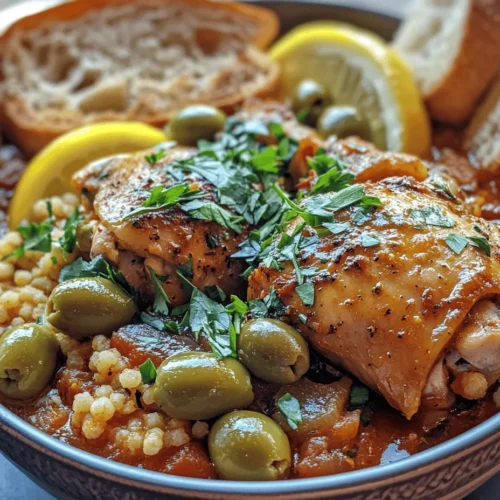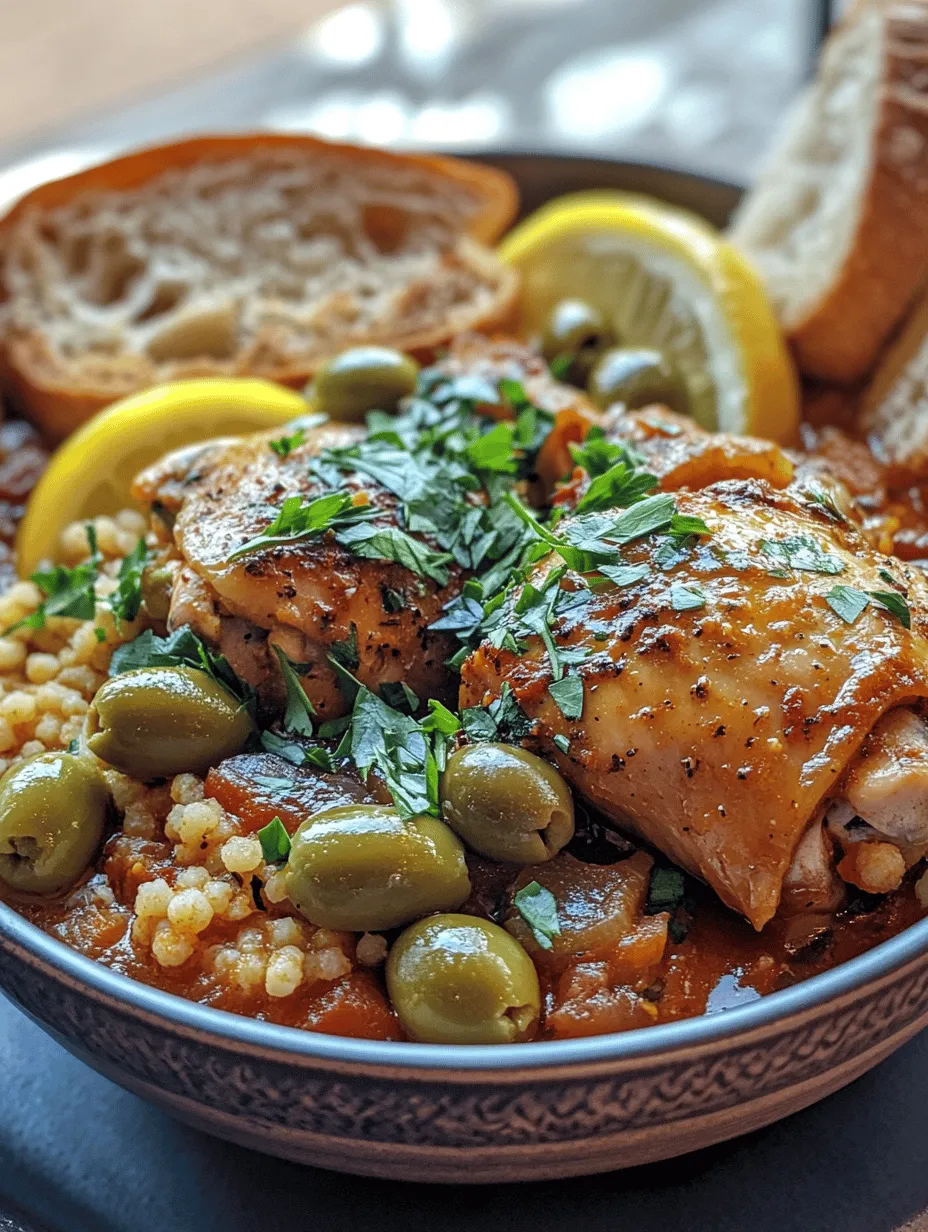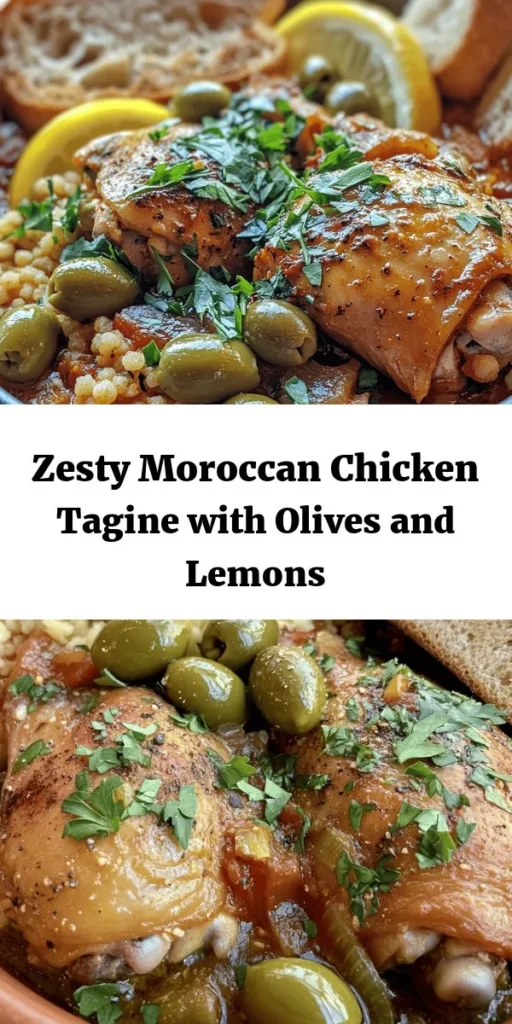Introduction to Moroccan Chicken Tagine
Moroccan Chicken Tagine with Olives and Lemons is a vibrant and flavorful dish that encapsulates the essence of Moroccan cuisine. Known for its rich spices and unique cooking method, tagine dishes are traditionally prepared in earthenware pots that retain moisture and enhance flavors. This iconic recipe combines tender chicken thighs with aromatic spices, briny olives, and zesty preserved lemons, creating a delightful balance of flavors that dance on the palate.
The tagine itself, a conical-shaped cooking pot, is a hallmark of Moroccan culinary tradition. It serves not only as a cooking vessel but also as a symbol of communal dining and hospitality. In Moroccan culture, meals are often shared among family and friends, and tagine dishes are a centerpiece of these gatherings. The slow-cooking method allows the ingredients to meld beautifully, resulting in a dish that is not only nourishing but also steeped in rich history.
As we delve into the origins and preparation of Moroccan Chicken Tagine, you will discover the significance of its ingredients and the steps to recreate this delectable dish in your own kitchen. Whether you are familiar with Moroccan cuisine or embarking on a new culinary adventure, this dish promises to transport you to the bustling markets and fragrant spice bazaars of Morocco.
The Origins of Tagine Cooking
Understanding the cultural significance of tagine cooking adds depth to this culinary experience. The word “tagine” refers to both the dish and the cooking method, which has been a staple in Moroccan households for centuries. The origins of tagine cooking can be traced back to the Berber people of North Africa, who utilized clay pots to cook stews over an open flame. This method not only preserves moisture but also infuses the dish with unique flavors derived from the interaction between the ingredients and the pot.
Historically, tagine dishes were not only practical but also symbolic. They embody the essence of Moroccan hospitality, as meals are often enjoyed communally, with diners gathering around a single pot. The act of sharing food fosters connections and strengthens bonds among family and friends. In Moroccan culture, special occasions and family gatherings frequently feature tagine dishes, making them an integral part of the culinary landscape.
Traditional methods of cooking with a tagine pot involve a careful balance of heat and time. The conical lid allows steam to circulate, ensuring that the ingredients cook evenly and retain their moisture. This technique is particularly ideal for tougher cuts of meat, such as chicken thighs, which become tender and succulent after slow cooking. The result is a dish that is infused with the rich aromas of spices, herbs, and other ingredients.
As we explore the preparation of Moroccan Chicken Tagine, it is essential to appreciate the significance of the cooking method and the cultural heritage that accompanies it. This dish is more than just a meal; it is a celebration of flavors, traditions, and the joy of sharing food with loved ones.
Ingredients Breakdown
A closer look at each ingredient reveals how they contribute to the overall flavor profile of the dish. The key to a successful Moroccan Chicken Tagine lies in the quality and selection of ingredients. Here’s a detailed breakdown of what you will need:
– Chicken Thighs: For this recipe, bone-in and skin-on chicken thighs are preferred. The bones add depth to the flavor and the skin helps to keep the meat moist during cooking. Thighs are particularly well-suited for slow cooking, as they remain tender and juicy, soaking up the spices and flavors of the tagine.
– Aromatics: Onions and garlic play a crucial role in flavor development. Onions add sweetness and depth, while garlic contributes a robust aroma. Sautéing these aromatics at the beginning of the cooking process creates a fragrant base for the dish.
– Spices: Moroccan cuisine is renowned for its bold use of spices, and this tagine is no exception. Cumin, coriander, ginger, cinnamon, and paprika are the stars of the spice blend. Each spice brings its unique characteristics; for instance, cumin adds warmth, coriander brings citrus notes, ginger provides a hint of heat, cinnamon adds sweetness, and paprika lends a smoky flavor.
– Preserved Lemons: A hallmark of Moroccan cooking, preserved lemons add a distinct tang and depth of flavor to dishes. The lemons are cured in salt, which intensifies their tartness while softening their texture. They are typically diced and added toward the end of cooking, allowing their bright flavors to infuse the dish.
– Olives: Green olives, such as Castelvetrano or Kalamata, provide a briny contrast to the sweetness of the spices and the tartness of the preserved lemons. Their inclusion adds complexity and richness to the dish, enhancing its overall flavor profile.
– Fresh Herbs: Cilantro and parsley are essential for garnishing the finished dish. They not only add a pop of color but also contribute freshness and brightness, balancing the richness of the tagine.
– Optional Honey: A drizzle of honey can be added for those who enjoy a hint of sweetness in savory dishes. This optional ingredient can enhance the overall flavor balance, complementing the spices and preserved lemons beautifully.
Preparation Steps for Moroccan Chicken Tagine
Now that we have explored the origins and ingredients of Moroccan Chicken Tagine, let’s dive into the preparation steps. This comprehensive, step-by-step guide will ensure clarity and ease as you embark on creating this flavorful dish at home.
Step 1: Preparation of the Chicken
Before cooking, it’s essential to prepare the chicken properly. Start by rinsing the chicken thighs under cold water to remove any residual salt or impurities. Pat them dry with paper towels to ensure a good sear later on.
Next, season the chicken generously with salt and pepper. This step is crucial, as it enhances the flavor of the meat and forms a flavorful crust during cooking. For an extra layer of flavor, you can also marinate the chicken in a mixture of spices (cumin, coriander, ginger, cinnamon, and paprika) for at least 30 minutes, or preferably overnight in the refrigerator. This will allow the spices to penetrate the meat and create a more aromatic dish.
Step 2: Sautéing the Aromatics
Heat a tagine pot or a heavy-bottomed Dutch oven over medium heat. Once heated, add a few tablespoons of olive oil to the pot. Allow the oil to warm before adding the sliced onions. Sauté the onions until they become translucent and slightly caramelized, which usually takes about 5-7 minutes. The goal is to develop a deep, rich flavor base that will enhance the overall dish.
After the onions are ready, add minced garlic and continue to sauté for an additional minute until fragrant. Be cautious not to burn the garlic, as it can impart a bitter taste to the dish. Once the aromatics are softened and fragrant, you can proceed to the next step.
This initial phase of cooking is vital, as it sets the foundation for the flavors that will develop throughout the cooking process. The combination of sautéed onions and garlic creates a fragrant base that will permeate the entire tagine, ensuring every bite is infused with rich flavor.
As you prepare the Moroccan Chicken Tagine, remember that cooking is not just about following a recipe; it’s about embracing the process and enjoying the journey of creating something delicious. With each step, you are bringing the vibrant essence of Moroccan cuisine into your kitchen, ready to share with family and friends.
Stay tuned for the next part, where we will delve into the remaining steps of preparing this delightful dish, ensuring that you achieve the perfect Moroccan Chicken Tagine with Olives and Lemons in your own home.

Toasting Spices: Enhancing Flavor Through Proper Cooking
Toasting spices is a fundamental technique that elevates the flavor profile of Moroccan Chicken Tagine with Olives and Lemons. The process involves heating whole spices in a dry skillet over medium heat until they become fragrant. This step is crucial as it releases the essential oils locked within the spices, enhancing their natural flavors and aroma.
For this recipe, consider using spices such as cumin, coriander, and cinnamon. Toasting them for about 2 to 3 minutes, stirring frequently, will result in a richer, more complex taste in your dish. Once toasted, remove the spices from the heat and allow them to cool slightly before grinding them to a fine powder if you are using whole spices. This simple step can significantly transform your tagine from ordinary to extraordinary.
Browning the Chicken: Achieving the Perfect Sear
Browning the chicken is another vital step in crafting a flavorful Moroccan Chicken Tagine. Start by heating olive oil in your tagine or Dutch oven over medium-high heat. Season the chicken pieces with salt and pepper, then add them to the hot oil in batches to avoid overcrowding the pan.
The goal here is to achieve a golden-brown crust on the chicken. This process not only adds depth of flavor but also creates a beautiful base for your tagine. Allow the chicken to sear for about 5-7 minutes on each side until it reaches a rich golden color. Once browned, remove the chicken from the pot and set it aside. This step is crucial in building layers of flavor that will permeate the entire dish during the simmering process.
Adding Liquid: The Importance of Deglazing for Flavor
After browning the chicken, it’s time to build the sauce that will flavor your tagine. Start by adding chopped onions to the same pot, using the residual oil and fond left from the chicken to create a savory base. Sauté the onions until they start to soften and turn translucent, which should take about 5 minutes.
Next, deglaze the pot by adding a splash of chicken broth or water. Use a wooden spoon to scrape up the flavorful browned bits stuck to the bottom of the pot. This technique infuses your tagine with even more flavor. Once deglazed, add the toasted spices, garlic, and other ingredients like preserved lemons and olives to the pot, stirring to combine.
Simmering: Tips for Ensuring the Chicken is Tender and Flavorful
Once your flavor base is prepared, return the browned chicken to the pot. Add enough chicken broth to cover the chicken halfway, along with additional seasonings like saffron, bay leaves, and a touch of honey for sweetness. Bring the mixture to a simmer, then reduce the heat to low.
Cover the tagine or pot with a lid and let it simmer gently for about 45 minutes to 1 hour. This slow-cooking method allows the chicken to become incredibly tender while absorbing all the aromatic flavors. It’s essential to check occasionally to ensure the liquid doesn’t evaporate completely; if it gets too low, add a splash more broth or water.
Finishing Touches: Garnishing and Serving Suggestions
As your Moroccan Chicken Tagine nears completion, consider how you’d like to garnish and present it. Fresh herbs, such as cilantro or parsley, can add a vibrant touch when sprinkled on top before serving. Additionally, you can add lemon zest to enhance the citrus notes of the dish.
When it comes to serving, a traditional Moroccan tagine is often presented directly in the cooking vessel. Consider pairing your tagine with fluffy couscous, which can soak up the delicious sauce. Alternatively, warm crusty bread is excellent for dipping and enjoying the rich flavors.
Cooking Techniques and Tips
Moroccan cuisine is known for its unique cooking methods, and understanding them can enhance your tagine experience. The tagine itself—a conical clay pot—allows for steam to build up and circulate, making it ideal for slow-cooking stews. If you don’t have a tagine, a Dutch oven or heavy-bottomed pot works just as well.
Simmering is crucial in developing the flavors of your dish. This slow cooking process allows the spices to meld together, creating a depth that cannot be rushed. If you’re looking to adjust the recipe for different dietary preferences, consider substituting chicken with chickpeas or tofu for a vegetarian option. You can also reduce the fat content by using skinless chicken thighs or breasts.
Serving Suggestions
To complement your Moroccan Chicken Tagine, consider serving it with a variety of side dishes that enhance the dining experience. Fluffy couscous is a classic pairing, but you can also serve it with a refreshing salad, such as a simple cucumber and tomato salad dressed with lemon and olive oil.
For a more substantial meal, add roasted vegetables or a spiced chickpea salad. When it comes to beverages, traditional Moroccan mint tea is an excellent choice, as its sweetness and minty flavor balance the spices in the tagine. Alternatively, consider serving it with a light white wine or sparkling water infused with citrus for a refreshing touch.
Presentation is key to creating an authentic Moroccan dining experience. Serve the tagine in the cooking vessel, garnished with fresh herbs and lemon slices, and place couscous or bread on a shared platter. This communal style of dining encourages sharing and conversation, making the meal even more enjoyable.
Nutritional Information
Moroccan Chicken Tagine with Olives and Lemons is not only delicious but also nutritious. A typical serving contains approximately 400-500 calories, depending on portion sizes and specific ingredients used. The chicken provides a good source of protein, while olives and lemons add healthy fats and vitamins.
The dish is rich in flavor yet balanced, featuring a variety of spices that offer health benefits. For instance, turmeric has anti-inflammatory properties, and cumin is known to aid digestion. The inclusion of vegetables, olives, and herbs enhances the dish’s nutritional profile, making it a wholesome meal choice.
Conclusion
Moroccan Chicken Tagine with Olives and Lemons is more than just a recipe; it’s an invitation to experience the rich tapestry of Moroccan culture through its food. By following this detailed guide, you can bring a taste of Morocco into your kitchen, impress your family or guests, and enjoy a dish that is as nourishing as it is delicious. With its harmonious blend of flavors and textures, this tagine is sure to become a cherished addition to your culinary repertoire.
The process of creating this dish—from toasting spices to slow-simmering the chicken—allows you to connect with the authentic techniques of Moroccan cuisine. So, gather your ingredients, prepare your tagine, and embark on a culinary journey that celebrates the vibrant flavors of Morocco.



